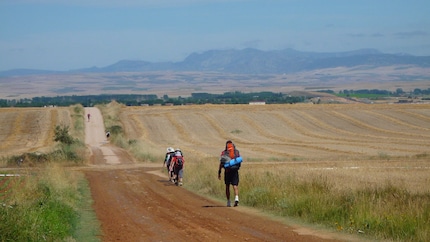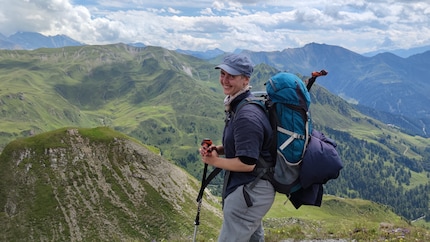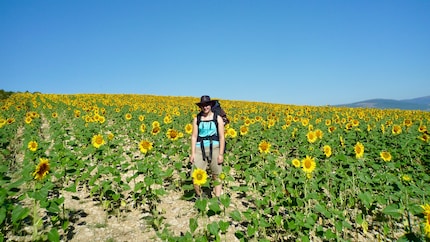
Background information
First world problems: when children don’t know what to wish for
by Michael Restin

From Finland to Spain – Linn Schiffmann enjoys long-distance hiking trails. She’s already hiked in eight countries and has written a book about her experiences. In this interview, she shares her top tips.
Linn Schiffmann is an author and freelance artist. Ever since she was young, long-distance hiking has been one of her passions. She’s explored hiking trails in Norway, the Spanish section of the Camino de Santiago, the West Highland Way in Scotland and the Hirvaan Kierros in Finland. She’s also hiked the Inntal High Trail in the Alps and is always out and about in Germany’s uplands and regions like the Sauerland.
Every journey starts with the first step. What was yours?
Now you’ve done something similar. You’ve hiked a lot, in eight countries across Europe and 1,700 km on long-distance hiking trails. And you’ve written a book about it.
Yes, they’re stories about events and encounters on the Camino, the West Highland Way in Scotland and the paths in Salamajärvi National Park in Finland as well as the Austrian Alps and the Sauerland. There are also some fictional stories thrown in.
That’s quite an unusual mix for travel literature.
You did your first multi-day hike aged 16. Then at 20, you walked the Spanish part of the Camino de Santiago – the most popular route called the Camino Francés. And you’ve been on longer hikes ever since. Now aged 34, you ask yourself in the title of your book: why are you actually doing this?
Without a doubt because of the many great encounters and conversations along the way. For me, that’s a really important part of it. And of course, there are those times when I’m tired, my feet hurt, I can’t find accommodation and it rains for days on end. It’s at those points that I ask myself why I’m actually doing this. But obviously, the best stories are also born out of things going wrong.
What’s the biggest appeal for you?
Hiking is just such a huge contrast to everyday life, where I sit in front of the computer a lot and exercise my mind. Writing and painting are important parts of my life, but I feel much more alive when I’m outside. I also like the self-determination of hiking. I’m allowed to, and in fact have to, make decisions while out on the trail practically all the time, and that’s appealing.
How has hiking changed your life?
What do you like in particular about meeting people while out hiking?
I realise every trail is unique, but do you have a favourite?
But you must surely come up against challenges as well.
Yes, for example in Scotland, when I encountered rutting stags fighting with each other. I didn’t want to get caught in the middle of it. Once, a doe was standing on the path with her fawn and was wheezing angrily. I quickly disappeared into the bushes. But you can come face to face with animals anywhere. With heifers, for example. You get this on the edge of the Alps as well as in the Sauerland.
What tips would you give beginners?
Preparation is imperative. For instance, reading about other people’s experiences, familiarising yourself with the map and compass and testing your equipment. If you want to hike a longer route with your partner, why not try a trail one weekend and see if your pace, fitness level, risk aversion and hiking level are compatible. This can avoid a lot of frustration and conflict.
Are there any long-distance hiking trails you’d recommend for someone’s first longer expedition?
What’s your top tip when it comes to equipment?
While we’re on the subject of feet, what about shoes?
What other tips do you have when it comes to equipment?
Interesting. What else is in your rucksack?
It’s not a good idea to cut corners with your first aid kit. Especially not when it comes to plasters. If you take some that don’t stick properly or come loose at the slightest bit of sweat or moisture, you’ll soon find yourself in a predicament. And often, you’ll be in areas where you simply can’t buy plasters or bandages.
Is there anything else you’ve learned over time in terms of equipment?
It’s important to take a [sleeping bag](/search?q=sleeping bag) that’s actually warm enough. Even in summer, nights can be cool – especially in Scandinavian countries. And if you’re cold at night, you won’t have the energy for hiking the next day. That’s why I prefer taking a slightly warmer sleeping bag and looking up how low the temperatures can drop at a particular time of year.
Long-distance hikes are on a lot of people’s bucket lists. So far, have your hikes been more of a dream or disillusionment?
As a matter of fact, many set out to gain clarity about their future, career or a relationship. They don’t always get the inspiration they’d hoped for. I didn’t set out with such high expectations. I just thought it might be interesting and perhaps even fun – and that’s exactly what it was.
Thanks, Linn, for this interview and sharing your exciting world of hiking.
If you’re looking for more tips on hiking equipment – some serious, some more light-hearted – you can find them here.
Research diver, outdoor guide and SUP instructor – I love being in, on and around water. Lakes, rivers and the ocean are my playgrounds. For a change of perspective, I look at the world from above while trail running or flying drones.
Interesting facts about products, behind-the-scenes looks at manufacturers and deep-dives on interesting people.
Show all
Background information
by Michael Restin

Background information
by Michael Restin

Background information
by Ann-Kathrin Schäfer
It was actually two steps, or events, that were roughly in tandem. One was a trip to Norway when I was younger. We hiked for four days in a row. I really enjoyed being in the great outdoors and spending time with other people. The other pivotal moment was stumbling upon the book «Ich bin dann mal weg» (only in German) by Hape Kerkeling. I was totally enthralled by it, with the mixture of stories from his life and the fairly precise description of the Camino.
Yes, but it doesn’t always have to be report-like. While hiking, you can let inspiration strike and dream about what might happen in a fictional world. For example, what would happen if aliens suddenly appeared on a hiking trail. People can have very different opinions when it comes to hiking and reading. Some want to know the specifics, such as whether they should veer off at the 15th km, while others aren’t bothered. These are the dreamers who like to imagine what a place could’ve been.
That’s a difficult question, because I started very young and a lot is still changing. But one thing’s certainly done a full 180. I didn’t like hiking as a child. I never found half-day trips with my parents particularly exciting. In fact, my enthusiasm for hiking didn’t start until my Norway trip. Being out in nature with lots of people for a few days and camping out overnight really captivated me. And although it sounds like I’m treading the same path, I have to again mention the importance of encounters and conversations.

Long-distance hiking trails are so international. You hear all sorts of languages and come across people from diverse regions with very different motivations that I’d never have encountered otherwise. And although we follow the same path, we all experience it differently. For some, walking along the cliffs is terrifying because they’re scared of heights, while others enjoy the fantastic view. Some find straight, flat paths particularly beautiful and meditative, while others get bored. I’ve learned that lonely trails aren’t my thing, even if they are scenically beautiful. I love interacting with other people, and solo tours through the forest just aren’t the best for that.
Every route has its own characteristics and each one is great. But I have to say I’ve got particularly fond memories of the Inntal High Trail. It was also the most challenging hike so far, as I had to pay attention in the mountains in a completely different way. I was always wondering if the weather would be on my side and whether I had enough warm clothes and food with me. But when walking at an altitude of 2,000 m in good weather, I always had stunning views and a new highlight every day. It was great, but at the same time I have to admit I find hiking in low mountain ranges more relaxing.

A trail such as the Camino is certainly a good place to start. There are plenty of accommodation and shopping options, so hikers don’t have to worry about having enough provisions with them. The trail is also pretty forgiving. However, it’s now so popular that it’s worth booking accommodation in advance, especially on the final stages. Guided tours, such as those in Finland, are also great for novices. They’re even helpful later on in your hiking journey, because having a guide means you can concentrate on the experience and the route without needing to worry too much about planning and logistics.

I found compression socks an absolute game changer. I always had blisters on my feet and tried to find the right shoes. Or tried other tips, like wearing two pairs of socks, but none of it helped. Until I realised that my feet swell when I’m hiking and this causes friction in my shoes, no matter what size I have. What solved this problem was hiking compression socks. It may be different for other hikers, but these socks proved a real help for me.
I’m now a fan of walking in trail running shoes instead of heavy hiking boots – unless you’re in the mountains or hiking in winter. Having less weight on your feet with trail running shoes makes a real difference. I also make sure I choose models from barefoot shoe brands. It’s not that I’m avoiding cushioning or tread. I just value a roomy toe box. I like to make sure my foot isn’t compressed as I already have misaligned ankles and knees from wearing shoes that are too tight.
Don’t take too much with you. It helps to take a smaller rucksack that won’t fit so much. This practically forces you to focus on the essentials. One item I wouldn’t want to do without is my hydration pack. I find it much better than a bottle. Instead of drinking a large amount once an hour, I just keep taking sips. This stops me getting really thirsty in the first place and means I don’t have to go to the toilet as often.


Acer Nitro VG271UM3bmiipx
2560 x 1440 pixels, 27"